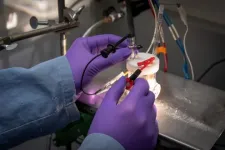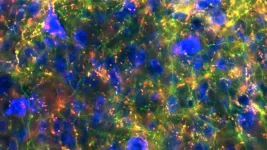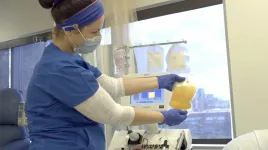International team identifies genetic link between face and brain shape
2021-04-05
(Press-News.org) An interdisciplinary team led by KU Leuven and Stanford has identified 76 overlapping genetic locations that shape both our face and our brain. What the researchers didn't find is evidence that this genetic overlap also predicts someone's behavioural-cognitive traits or risk of conditions such as Alzheimer's disease. This means that the findings help to debunk several persistent pseudoscientific claims about what our face reveals about us.
There were already indications of a genetic link between the shape of our face and that of our brain, says Professor Peter Claes from the Laboratory for Imaging Genetics at KU Leuven, who is the joint senior author of the study with Professor Joanna Wysocka from the Stanford University School of Medicine. "But our knowledge on this link was based on model organism research and clinical knowledge of extremely rare conditions," Claes continues. "We set out to map the genetic link between individuals' face and brain shape much more broadly, and for commonly occurring genetic variation in the larger, non-clinical population."
Brain scans and DNA from the UK Biobank
To study genetic underpinnings of brain shape, the team applied a methodology that Peter Claes and his colleagues had already used in the past to identify genes that determine the shape of our face. Claes: "In these previous studies, we analysed 3D images of faces and linked several data points on these faces to genetic information to find correlations." This way, the researchers were able to identify various genes that shape our face.
For the current study, the team relied on these previously acquired insights as well as the data available in the UK Biobank, a database from which they used the MRI brain scans and genetic information of 20,000 individuals. Claes: "To be able to analyse the MRI scans, we had to measure the brains shown on the scans. Our specific focus was on variations in the folded external surface of the brain - the typical 'walnut shape'. We then went on to link the data from the image analyses to the available genetic information. This way, we identified 472 genomic locations that have an impact on the shape of our brain. 351 of these locations have never been reported before. To our surprise, we found that as many as 76 genomic locations predictive of the brain shape had previously already been found to be linked to the face shape. This makes the genetic link between face and brain shape a convincing one."
The team also found evidence that genetic signals that influence both brain and face shape are enriched in the regions of the genome that regulate gene activity during embryogenesis, either in facial progenitor cells or in the developing brain. This makes sense, Wysocka explains, as the development of the brain and the face are coordinated. "But we did not expect that this developmental cross-talk would be so genetically complex and would have such a broad impact on human variation."
No genetic link with behaviour or neuropsychiatric disorders
At least as important is what the researchers did not find, says Dr Sahin Naqvi from the Stanford University School of Medicine, who is the first author of this study. "We found a clear genetic link between someone's face and their brain shape, but this overlap is almost completely unrelated to that individual's behavioural-cognitive traits."
Concretely: even with advanced technologies, it is impossible to predict someone's behaviour based on their facial features. Peter Claes continues: "Our results confirm that there is no genetic evidence for a link between someone's face and that individual's behaviour. Therefore, we explicitly dissociate ourselves from pseudoscientific claims to the contrary. For instance, some people claim that they can detect aggressive tendencies in faces by means of artificial intelligence. Not only are such projects completely unethical, they also lack a scientific foundation."
In their study, the authors also briefly address conditions such as Alzheimer's, schizophrenia, and bipolar disorder. Claes: "As a starting point, we used the results that were previously published by other teams about the genetic basis of such neuropsychiatric disorders. The possible link with the genes that determine the shape of our face had never been examined before. If you compare existing findings with our new ones, you see a relatively large overlap between the genetic variants that contribute to specific neuropsychiatric disorders and those that play a role in the shape of our brain, but not for those that contribute to our face." In other words: our risk of developing a neuropsychiatric disorder is not written on our face either.
INFORMATION:
This research is a collaboration between KU Leuven, Stanford University School of Medicine, University of Pittsburgh, Pennsylvania State University, Indiana University Purdue University Indianapolis, Cardiff University, and George Mason University.
ELSE PRESS RELEASES FROM THIS DATE:
2021-04-05
Journal Name: Nature Methods
Title of the Article: Discovering multiple types of DNA methylation from individual bacteria and microbiome using nanopore sequencing
Corresponding Author: Gang Fang, PhD
Bottom Line:
Bacterial DNA methylation occurs at diverse sequence contexts and plays important functional roles in cellular defense and gene regulation. An increasing number of studies have reported that bacterial DNA methylation has important roles affecting clinically relevant phenotypes such as virulence, host colonization, sporulation, biofilm formation, among others.
Bacterial methylomes contain three ...
2021-04-05
What The Study Did: A clinical risk assessment tool developed in China was tested with a group of patients in Spain to evaluate its ability to predict critical illness among patients hospitalized with COVID-19 in Europe.
Authors: Oscar Moreno-Perez, M.D., Ph.D., of the Alicante General University Hospital-Alicante Institute of Sanitary and Biomedical Research in Alicante, Spain, is the corresponding author.
To access the embargoed study: Visit our For The Media website at this link https://media.jamanetwork.com/
(doi:10.1001/jamainternmed.2021.0491)
Editor's Note: The article includes conflicts of interest disclosures. Please see the article for additional information, including other authors, author contributions and affiliations, conflict of interest and financial disclosures, and ...
2021-04-05
What The Study Did: The 30-day incidence of outpatient and hospital-associated blood clots following SARS-CoV-2 testing among adults in a large health system was examined in this study.
Authors: Nareg H. Roubinian, M.D., of Kaiser Permanente Northern California in Oakland, is the corresponding author.
To access the embargoed study: Visit our For The Media website at this link https://media.jamanetwork.com/
(doi:10.1001/jamainternmed.2021.0488)
Editor's Note: The article includes conflicts of interest and funding/support disclosures. Please see the article for additional information, ...
2021-04-05
What The Study Did: Researchers investigated the association of sociodemographic factors and blood group type with the risk of SARS-CoV-2 infection and severity of COVID-19.
Authors: Jeffrey L. Anderson, M.D., of the Intermountain Medical Center Heart Institute in Salt Lake City, is the corresponding author.
To access the embargoed study: Visit our For The Media website at this link https://media.jamanetwork.com/
(doi:10.1001/jamanetworkopen.2021.7429)
Editor's Note: The article includes conflicts of interest disclosures. Please see the ...
2021-04-05
What The Study Did: Electronic health record data were used to examine whether the transition to remote cardiology clinic visits during COVID-19 is associated with disparities in patient use of care, diagnostic test ordering and medication prescribing.
Authors: Neal Yuan, M.D., of Cedars-Sinai Medical Center in Los Angeles, is the corresponding author.
To access the embargoed study: Visit our For The Media website at this link https://media.jamanetwork.com/
(doi:10.1001/jamanetworkopen.2021.4157)
Editor's Note: The article includes conflicts of interest and funding/support disclosures. Please see the article for additional information, including other authors, author ...
2021-04-05
More snow is melting during winter across the West, a concerning trend that could impact everything from ski conditions to fire danger and agriculture, according to a new University of Colorado Boulder analysis of 40 years of data.
Researchers found that since the late 1970s, winter's boundary with spring has been slowly disappearing, with one-third of 1,065 snow measurement stations from the Mexican border to the Alaskan Arctic recording increasing winter snowmelt. While stations with significant melt increases have recorded them mostly in November and March, the researchers found that melt is increasing in all cold season ...
2021-04-05
Three years ago, scientists at the University of Michigan discovered an artificial photosynthesis device made of silicon and gallium nitride (Si/GaN) that harnesses sunlight into carbon-free hydrogen for fuel cells with twice the efficiency and stability of some previous technologies.
Now, scientists at the Department of Energy's (DOE's) Lawrence Berkeley National Laboratory (Berkeley Lab) - in collaboration with the University of Michigan and Lawrence Livermore National Laboratory (LLNL) - have uncovered a surprising, self-improving property in Si/GaN that contributes to the material's highly efficient and stable performance ...
2021-04-05
Thousands of our daily activities, from making coffee to taking a walk to saying hello to a neighbor, are made possible through an ancient collection of brain structures tucked away near the center of the cranium.
The cluster of neurons known as the basal ganglia is a central hub for regulating a vast array of routine motor and behavior functions. But when signaling in the basal ganglia is weakened or broken, debilitating movement and psychiatric disorders can emerge, including Parkinson's disease, Tourette's syndrome, attention deficit hyperactivity disorder (ADHD) and obsessive-compulsive ...
2021-04-05
Alzheimer's disease treatments that slow progression of the disease could significantly reduce the financial burden to U.S. state budgets, according to a new USC study.
The study outlines how states -- which have been hit particularly hard by the COVID-19 pandemic -- would see relief: Medicare would cover the costs of treating the disease, while Medicaid expenditures would be reduced due to fewer patients entering nursing homes.
Assuming a 40% relative reduction of Alzheimer's disease progression rates with treatment, researchers projected two decades of savings beginning in 2021, using a simulation model of state Medicaid programs. They forecast annual savings for Medicaid programs of $7.4 billion in 2030; by 2040, the annual savings would be more than $22 billion.
All ...
2021-04-05
March 10, 2021 - Hackensack, NJ - Convalescent plasma, the use of survivors' antibodies transfused into sick COVID-19 patients is safe and significantly improves clinical outcomes when using high levels of antibodies, according to a new publication by scientists at Hackensack Meridian Health, New Jersey's largest and most comprehensive health network.
The treatment was safe, transferred the survivors' antibodies, and did not prevent the recipients from making their own antibodies, according to the results published recently in the journal JCI Insights.
"We have developed this technique and methodology to save the lives of patients," said Michele Donato, ...
LAST 30 PRESS RELEASES:
[Press-News.org] International team identifies genetic link between face and brain shape




